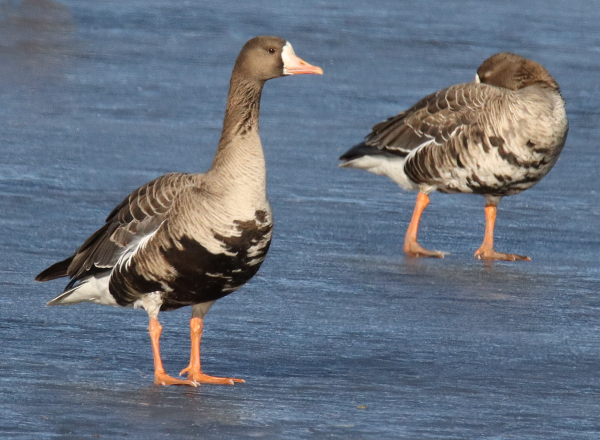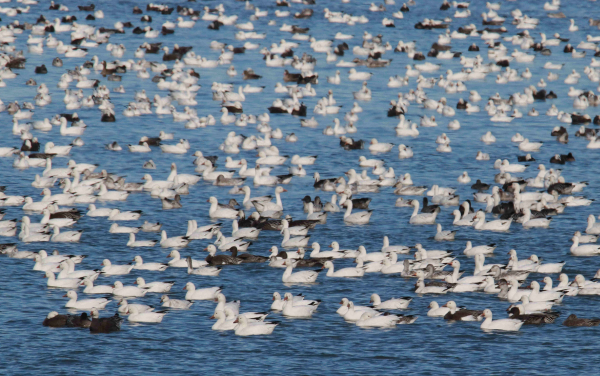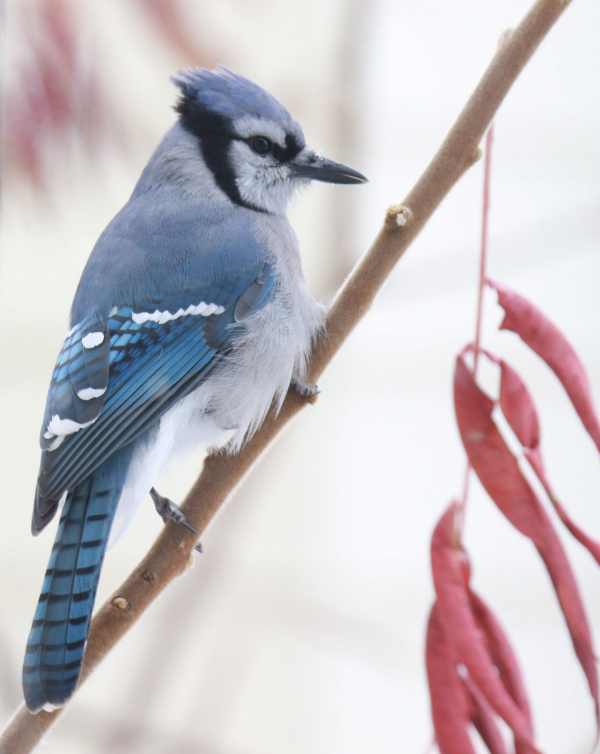
The colder weather over the weekend not only formed ice on some shallow marshes, it pushed some birds south, including most White-fronted Geese.

The first huge flock of Snow and Ross’s Geese rested on the surface of a beautiful blue prairie lake last Wednesday.

Thursday a mile-long flock of white geese provided photo opportunities as the fed on the edge of a harvested cornfield. Note the small heads of the pair of Ross’s Geese standing in the front-center next to the young blue Snow Goose – all positioned between the pair of adult blue morph Snow Geese.

A mixed group of Snow Geese with Ross’s Geese, now a familiar sight with goose numbers reaching ever-closer to the hundred thousand mark in the area.

Perched just inches from 1 of 4 bay windows, this Blue Jay’s vibrant colors are set off by the red sumac leaves.
|
Big Freeze Monday initiated the first phase of the “big freeze,” which was obvious during a morning birding drive that showed the surface of most shallow marshes covered by ice. Although marshes have the potential to become ice-free again with temps warming into the high 40s and low 50s during the next few days, the deep lakes remain ice-free. The associated cold north wind pushed thousands of new Snow Geese and Ross’s Geese into the immediate area, so that now it’s hard to count individual flocks, or estimate the numbers of geese on hand, so I’m resorting to describing the volume of geese in the immediate area in the numbers of miles the mega-flocks cover.
Seriously, starting 1/4 mile south of home, a concentration of Snows and Ross’s Geese extended south almost 3 miles, with another mega-flock a couple miles southwest extended 1½ across another harvested cornfield. A third flock was also feeding 2 miles northwest of home that extended a mile north. Without question, goose numbers were in the tens of thousands and increasing, seemingly by the hour. But not many other birds were to be seen; only a few flocks of Mallards, a young Bald Eagle, a very late Mourning Dove, and a late Great Blue Heron (flying north at the time).
Arctic Birds and Freezing Weather Arrive
In advance of the Big Freeze, I did a simple 12-mile birding drive from my office to Charo Thursday afternoon. As I rounded a curve in the road just 2 miles south, I could see about 100 Snow Geese divided between a lake and a harvested cornfield, but it seemed like the flock might spread beyond the hilltop above the lake. As it turned out, the flock of a few thousand Snow and Ross’s Geese extended across the expansive field and spilled into Grebe Marsh.
Best of all, the edge of the flock of geese was positioned just 70 feet from the road and extended almost a half-mile west. An oncoming pickup passed by without alarming the geese, so I tried stopping and was refreshed to take a few photographs of some of the closer family groups, some Ross’s Geese feeding among the Snows, and a mix of blue and white morph Snow Geese while appreciating the wild calls of huge concentration of waterfowl.
About 1½ miles south I encountered the next flock of a couple hundred Snows and Ross’s Geese, and a quarter-mile south of them on the other side of the road, a much larger flock of Snows was feeding, with a small sub-flock that included a mix of Canada Geese and Cackling Geese. Another 1½ miles south I counted 29 Tundra Swans and a flock of Gadwalls. Next was a Rough-legged Hawk, then another, and another – all after I turned east toward Charo Marsh, where there was also a Northern Harrier on a hunting flight. A flock of 4 Tundra Swans flew toward Charo, circled and left the way they came, and Charo’s water held mostly flocks of Mallards with some Redheads and Green-winged Teal evident.
At Swan Marsh I counted 15 Tundra Swans, and on a neighboring marsh there was another flock of Cackling Geese and Canada Geese (more Cacklers). An adult Bald Eagle was perched nearby and an adult Red-tailed Hawk rounded out the drive’s sightings, although I spent some more time on the edge of the big goose flock south of home before getting back to work.
Minnesota Sunday – A day trip to central Minnesota provided a couple memorable observations during a family birthday party, all assembled in a beautiful cabin where the woods met a tranquil central Minnesota lake. When I arrived, my nephew Casey pointed out a family group of 7 Trumpeter Swans positioned in the center of the front window view, and a couple hours later 2 young Trumpeter Swans provided nice looks for everyone just a few feet from the water’s edge. The biggest excitement would come a bit later, when my young nephew Blake and I heard, then observed a Pileated Woodpecker during a fun walk in the woods, which I describe in the Birding Lifestyles article in this issue.
Feeder Action – Last Thursday, 2 breakthroughs began with at least 5 American Goldfinches camping out at my feeding station along with as many or more House Finches. And a couple visits by 1 or more Blue Jays to branches above my feeders made me try something new to entice the jays to eat there. As it turned out, it was a simple fix: I simply added a shallow cup of shelled seeds with peanut halves to my bird bath platform, and “bingo,” there was an almost immediate reaction by at least 1 Blue Jay, with multiple visits throughout the rest of the afternoon – hooray!
Saturday morning was filled with surprises! For starters, the season’s first snow covered the ground with a bright white background that emphasized the elements of my feeding station and the birds that were much more active and varied than usual. In fact, there were 5 more surprises to witness – a first of fall Redpoll, Red-breasted Nuthatch, and Cedar Waxwing, and a Dark-eyed Junco that was the first junco to feed on my platform feeder rather than the ground. It was also the first time 4 Blue Jays arrived at once – how exciting! This was indeed the kind of payoff I’ve been hoping for, and the kind of surprises you can look forward to at your feeders. Apparently the new birds heard about the offer I made in last week’s column: “Come to Paul’s yard for free food and fresh water!”
It was great to watch the new birds, and it stirred me to try a few photos in the midst of the action with regular visitors joining in too, including White-breasted Nuthatches and House Finches, plus American Goldfinches that arrived a couple days before. The new snow provided a white canvas for photographs that turned out pretty well, and I was drawn away from my regular work to spend an hour or so photographing birds at one of the feeders and adjacent trees and perches. I followed through with a few more photos Monday noon, and share more photographs in this issue’s Backyard Birding article.
As expected, a 4-day blast of cold weather from Canada over the weekend expanded the numbers of birds in the surrounding area and the variety of birds at my feeders. It’s an exciting time of the season, as geese take over the surrounding landscape and skyscape, but bittersweet as the surface of some wetlands freeze, sending many recent stopover species south. The weather is already rebounding to previous temperatures, but it’s hard to say what excitement will follow among the birds in the tri-state area. Of course, I will share my week’s birding highlights with you in the next issue, along with some new photographs. By all means, enjoy this active season of fall migration and the birds that keep us in touch with the change of season.
Article and Photos by Paul Konrad
Share your bird sightings and photographs at editorstbw2@gmail.com